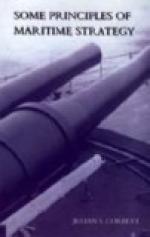The means was to tempt him with a prospect of success, either by leading him to believe the blockading force was smaller than it was, or by removing it to such a distance as would induce him to attempt to evade it, or both. A leading case of such an open blockade was Nelson’s disposition of his fleet off Cadiz when he was seeking to bring Villeneuve to action in 1805. But merely to leave a port open does not fulfil the idea of open blockade, and in this case to opportunity and temptation Nelson added the pressure of a commercial blockade of the adjacent ports in hope of starving Villeneuve into the necessity of taking to the sea.
Finally, in a general comparison of the two forms, we have to observe that close blockade is characteristically a method of securing local and temporary command. Its dominating purpose will usually be to prevent the enemy’s fleet acting in a certain area and for a certain purpose. Whereas open blockade, in that it aims at the destruction of an enemy’s naval force, is a definite step towards securing permanent command.
Enough has now been said to show that the question of choice between close and open blockade is one of extreme complexity. Our naval literature, it is true, presents the old masters as divided into two schools on the subject, implying that one was in favour of the close form always, and the other of the open form. We are even led to believe that the choice depended on the military spirit of the officer concerned. If his military spirit was high, he chose the close and more exacting form; if it were low, he was content with the open and less exacting form. True, we are told that men of the latter school based their objections to close blockade on the excessive wear and tear of a fleet that it involved, but it is too often suggested that this attitude was no more than a mask for a defective spirit. Seldom if ever are we invited to compare their decisions with the attendant strategical intention, with the risks which the conditions justified, or with the expenditure of energy which the desired result could legitimately demand. Yet all these considerations must enter into the choice, and on closer examination of the leading cases it will be found that they bear a striking and almost constant relation to the nature of the blockade employed.




